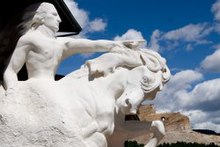Crazy Horse Memorial

A model of the planned statue, with the Crazy Horse Memorial in the background.
|
|
| Coordinates | 43°50′12.44″N 103°37′27.79″W / 43.8367889°N 103.6243861°WCoordinates: 43°50′12.44″N 103°37′27.79″W / 43.8367889°N 103.6243861°W |
|---|---|
| Location | Custer County, South Dakota, U.S. |
| Designer | Korczak Ziolkowski |
| Opening date | |
| Restored date | |
The Crazy Horse Memorial is a mountain monument under construction on privately held land in the Black Hills, in Custer County, South Dakota, United States. It will depict Crazy Horse, an Oglala Lakota warrior, riding a horse and pointing into the distance. The memorial was commissioned by Henry Standing Bear, a Lakota elder, to be sculpted by Korczak Ziolkowski. It is operated by the Crazy Horse Memorial Foundation, a private non-profit organization.
The memorial consists of the mountain carving (monument), the Indian Museum of North America, and the Native American Cultural Center. The monument is being carved out of Thunderhead Mountain on land considered sacred by some Oglala Lakota, between Custer and Hill City, roughly 17 miles (27 km) from Mount Rushmore. The sculpture's final dimensions are planned to be 641 feet (195 m) wide and 563 feet (172 m) high. The head of Crazy Horse will be 87 feet (27 m) high; by comparison, the heads of the four U.S. Presidents at Mount Rushmore are each 60 feet (18 m) high.
The monument has been in progress since 1948 and is far from completion. If completed, it may become the world's largest sculpture, as well as the first non-religious statue to hold this record since 1967 (when it was held by the Soviet monument The Motherland Calls).
Crazy Horse was a Native American war leader of the Oglala Lakota. He took up arms against the U.S. Federal government to fight against encroachments on the territories and way of life of the Lakota people. His most famous actions against the U.S. military included the Fetterman Fight (21 December 1866), and the Battle of the Little Bighorn (25–26 June 1876). He surrendered to U.S. troops under General Crook in May 1877, and was fatally wounded by a military guard while allegedly resisting imprisonment at Camp Robinson in present-day Nebraska. He ranks among the most notable and iconic of Native American tribal members and was honored by the U.S. Postal Service in 1982 with a 13¢ postage stamp as part of its Great Americans series.
...
Wikipedia
